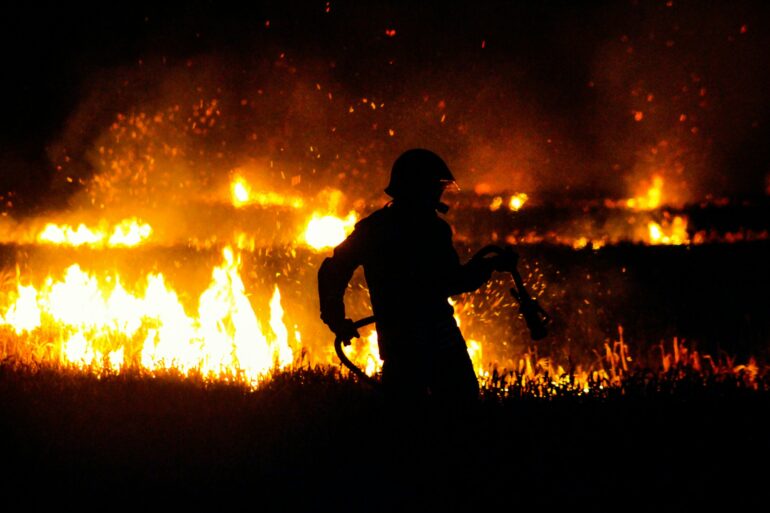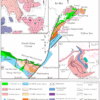Los Angeles is burning, and accelerating hydroclimate whiplash is the key climate connection. After years of severe drought, dozens of atmospheric rivers deluged California with record-breaking precipitation in the winter of 2022–23, burying mountain towns in snow, flooding valleys with rain and snow melt, and setting off hundreds of landslides.
Following a second extremely wet winter in southern parts of the state, resulting in abundant grass and brush, 2024 brought a record-hot summer and now a record-dry start to the 2025 rainy season, along with tinder-dry vegetation that has since burned in a series of damaging wildfires.
This is just the most recent example of the kind of “hydroclimate whiplash”—rapid swings between intensely wet and dangerously dry weather—that is increasing worldwide, according to a paper published in Nature Reviews Earth & Environment.
“The evidence shows that hydroclimate whiplash has already increased due to global warming, and further warming will bring about even larger increases,” said lead author Daniel Swain, a climate scientist with UCLA and UC Agriculture and Natural Resources.
“This whiplash sequence in California has increased fire risk twofold: first, by greatly increasing the growth of flammable grass and brush in the months leading up to fire season, and then by drying it out to exceptionally high levels with the extreme dryness and warmth that followed.”
Global weather records show hydroclimate whiplash has swelled globally by 31% to 66% since the mid-20th century, the international team of climate researchers found—even more than climate models suggest should have happened.
Climate change means the rate of increase is speeding up. The same potentially conservative climate models project that the whiplash will more than double if global temperatures rise 3 degrees Celsius above pre-industrial levels.
The world is already poised to blast past the Paris Agreement’s targeted limit of 1.5 C. The researchers synthesized hundreds of previous scientific papers for the review, layering their own analysis on top.
Anthropogenic climate change is the culprit behind the accelerating whiplash, and a key driver is the “expanding atmospheric sponge”—the growing ability of the atmosphere to evaporate, absorb and release 7% more water for every degree Celsius the planet warms, researchers said.
“The problem is that the sponge grows exponentially, like compound interest in a bank,” Swain said. “The rate of expansion increases with each fraction of a degree of warming.”
The global consequences of hydroclimate whiplash include not only floods and droughts, but the heightened danger of whipsawing between the two, including the bloom-and-burn cycle of overwatered then overdried brush, and landslides on oversaturated hillsides where recent fires removed plants with roots to knit the soil and slurp up rainfall. Every fraction of a degree of warming speeds the growing destructive power of the transitions, Swain said.
Many previous studies of climate whiplash have only considered the precipitation side of the equation, and not the growing evaporative demand. The thirstier atmosphere pulls more water out of plants and soil, exacerbating drought conditions beyond simple lack of rainfall.
Discover the latest in science, tech, and space with over 100,000 subscribers who rely on Phys.org for daily insights.
Sign up for our free newsletter and get updates on breakthroughs,
innovations, and research that matter—daily or weekly.
“The expanding atmospheric sponge effect may offer a unifying explanation for some of the most visible, visceral impacts of climate change that recently seem to have accelerated,” Swain said.
“The planet is warming at an essentially linear pace, but in the last five or 10 years there has been much discussion around accelerating climate impacts. This increase in hydroclimate whiplash, via the exponentially expanding atmospheric sponge, offers a potentially compelling explanation.”
That acceleration, and the anticipated increase in boom-and-bust water cycles, has important implications for water management.
“We can’t look at just extreme rainfall or extreme droughts alone, because we have to safely manage these increasingly enormous influxes of water, while also preparing for progressively drier interludes,” Swain said.
“That’s why ‘co-management’ is an important paradigm. It leads you to more holistic conclusions about which interventions and solutions are most appropriate, compared to considering drought and flood risk in isolation.”
In many regions, traditional management designs include shunting flood waters to flow quickly into the ocean, or slower solutions like allowing rain to percolate into the water table. However, taken alone, each option leaves cities vulnerable to the other side of climate whiplash, the researchers noted.
“Hydroclimate in California is reliably unreliable,” said co-author John Abatzoglou, a UC Merced climate scientist.
“However, swings like we saw a couple years ago, going from one of the driest three-year periods in a century to the once-in-a-lifetime spring 2023 snowpack, both tested our water-infrastructure systems and furthered conversations about floodwater management to ensure future water security in an increasingly variable hydroclimate.”
Hydroclimate whiplash is projected to increase most across northern Africa, the Middle East, South Asia, northern Eurasia, the tropical Pacific and the tropical Atlantic, but most other regions will also feel the shift.
“Increasing hydroclimate whiplash may turn out to be one of the more universal global changes on a warming Earth,” Swain said.
In California this week, although winds are fanning the extreme fires, it’s the whiplash-driven lack of rain that suspended Southern California in fire season.
“There’s not really much evidence that climate change has increased or decreased the magnitude or likelihood of the wind events themselves in Southern California,” Swain said. “But climate change is increasing the overlap between extremely dry vegetation conditions later in the season and the occurrence of these wind events. This, ultimately, is the key climate change connection to Southern California wildfires.”
Under a high warming scenario, California will see an increase in both the wettest and driest years and seasons by later this century.
“The less warming there is, the less of an increase in hydroclimate whiplash we’re going to see,” Swain said.
“So anything that would reduce the amount of warming from climate change will directly slow or reduce the increase in whiplash. Yet we are currently still on a path to experience between 2 degrees and 3 degrees Celsius of global warming this century—so substantial further increases in whiplash are likely in our future, and we really need to be accounting for this in risk assessments and adaptation activities.”
More information:
Swain, D.L., Prein, A.F., Abatzoglou, J.T. et al. Hydroclimate volatility on a warming Earth. Nat Rev Earth Environ 6, 35–50 (2025). doi.org/10.1038/s43017-024-00624-z , www.nature.com/articles/s43017-024-00624-z
Provided by
University of California, Los Angeles
Citation:
Research links intensifying wet and dry swings to the atmosphere’s sponge-like ability to drop and absorb water (2025, January 9)



